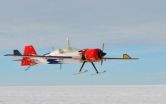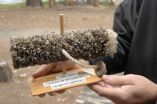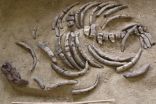(Press-News.org) JUPITER, FL, April 2, 2014 – A team led by a scientist from the Florida campus of The Scripps Research Institute (TSRI) has identified a new biomarker linked to better outcomes of patients with head and neck cancers and non-small cell lung cancer. The work could help scientists develop new diagnostics and therapies and help physicians determine the best long-term treatments for patients with these cancers.
The findings, which were published this week online ahead of print by the journal Cancer, focus on a protein called Choline phosphate cytidylyltransferase-α CCT-α or CCTα, an "antigen" that prompts the immune system to produce antibodies against it.
"Based on what we found, a high CCTα expression appears to be indicative of survival, making CCTα a promising biomarker," said Laura Niedernhofer, a TSRI associate professor who led the study with Gerold Bepler of the Karmanos Cancer Institute. "Our findings suggest that CCTα may, in fact, be more important in determining outcomes in patients with both types of cancer than the already established ERCC1."
The new study, in fact, turns previous studies on ERCC1 on their heads. Dozens of large clinical trials are being conducted using expression of the ERCC1 DNA-repair protein as a determinant of whether patients with lung, pancreatic, gastric, colorectal, esophageal or ovarian cancer should be treated with platinum-based therapy, a very potent but toxic DNA-damaging agent.
However, the new research suggests that these positive results were not actually due to ERCC1, but to CCTα—which also binds to the antibody most frequently used to measure ERCC1 expression. "Our results show CCTα may be a better predictor of patient outcomes than expression of ERCC1," said Niedernhofer.
While ERCC1 is associated with DNA repair, CCTα is involved in the synthesis of a major component of cell membranes, active in membrane-mediated signaling and embryo survival.
The new results were based on an examination of samples from 187 patients with non-small cell lung cancer and 60 patients with head and neck squamous cell carcinomas.
CCTα expression was associated with longer survival rates, including for patients with non-small cell lung cancer who were treated with surgery alone—without the use of platinum-based chemotherapy drugs and associated toxic side effects.
INFORMATION:
The first author of the study, "Choline Phosphate Cytidylyltransferase-α is a Novel Antigen Detected by the Anti-ERCC1 Antibody 8F1 with Biomarker Value in Patients with Lung and Head and Neck Squamous Cell Carcinomas," is Alec Vaezi of the University of Pittsburgh.
In addition to Niedernhofer, Bepler and Vaezi, other authors include Agnes Malysa and Wei Chen of the Karmanos Cancer Institute; and Nikhil Bhagwat, Jennifer Rubatt, Brian Hood, Thomas Conrads, Lin Wang and Carolyn Kemp of the University of Pittsburgh. For more information, see http://onlinelibrary.wiley.com/doi/10.1002/cncr.28643/abstract
The study was supported by National Institute of Environmental Health Sciences (grant R01-ES016114), the National Cancer Institute (grants R01-CA129343 and P50-CA097190) and the American Head and Neck Society.
About The Scripps Research Institute:
The Scripps Research Institute (TSRI) is one of the world's largest independent, not-for-profit organizations focusing on research in the biomedical sciences. TSRI is internationally recognized for its contributions to science and health, including its role in laying the foundation for new treatments for cancer, rheumatoid arthritis, hemophilia, and other diseases. An institution that evolved from the Scripps Metabolic Clinic founded by philanthropist Ellen Browning Scripps in 1924, the institute now employs about 3,000 people on its campuses in La Jolla, CA, and Jupiter, FL, where its renowned scientists—including three Nobel laureates—work toward their next discoveries. The institute's graduate program, which awards PhD degrees in biology and chemistry, ranks among the top ten of its kind in the nation. For more information, see http://www.scripps.edu.
Team identifies novel biomarker for head and neck cancer, non-small cell lung cancer
2014-04-02
ELSE PRESS RELEASES FROM THIS DATE:
Going global
2014-04-02
KANSAS CITY, MO - In textbooks, the grand-finale of cell division is the tug-of-war fought inside dividing cells as duplicated pairs of chromosomes get dragged in opposite directions into daughter cells. This process, called mitosis, is visually stunning to observe under a microscope. Equally stunning to cell biologists are the preparatory steps cells take to ensure that the process occurs safely.
Molecular biologists define those "cell cycle" steps as: G1, when cells survey chromosomes for damage and, if they pass muster, prepare to replicate them; S phase, in which ...
New model shows moderate resource use & reduced economic inequality keys to sustainability
2014-04-02
COLLEGE PARK, MD - A new analytical tool adds human factors to a widely-used biological model of how animal populations interact, suggesting that human societies can reach a steady state that is sustainable when they do not over-deplete natural resources and avoid extreme economic inequality.
The paper, titled "Human and nature dynamics (HANDY): modeling inequality and use of resources in the collapse or sustainability of societies," was published in the May 2014 issue of the journal Ecological Economics. Its authors are Safa Motesharrei, a Ph.D. candidate in applied ...
One or 2? How to decide how many species you have got
2014-04-02
It is often difficult to decide whether two animals belong to the same or two distinct species. This can be especially challenging for animals which externally look very similar. In a recent study, published in the open access journal Zoosystematics and Evolution, scientists from the Museum für Naturkunde Berlin use genetic data and sound analysis to test if treefrogs from West and Central Africa belong to different or the same species.
Due to the fact that, when external characters are used, only size is useful to distinguish these frogs the scientists employed additional ...
Remotely operated aircraft successfully tested as tool for measuring changes in polar ice sheets
2014-04-02
Scientists studying the behavior of the world's ice sheets--and the future implications of ice sheet behavior for global sea-level rise--may soon have a new airborne tool that will allow radar measurements that previously would have been prohibitively expensive or difficult to carry out with manned aircraft.
In a paper published in the March/ April edition of IEEE Geoscience and Remote Sensing Magazine, researchers at the Center for Remote Sensing of Ice Sheets (CReSIS) at the University of Kansas noted that they have successfully tested the use of a compact radar system ...
Don't move a mussel (or a clam, or a snail)
2014-04-02
(Millbrook, NY) Anyone that has spent time at a seaside pier has witnessed the destruction barnacles wreak on boat hulls. But biofouling animals are not limited to marine environments. A new paper published in the journal Frontiers in Ecology and the Environment estimates that the global management of freshwater mussels, clams, and other clinging animals costs $277 million U.S. dollars annually.
Biofoulers are organisms that accumulate underwater on hard surfaces, to the detriment of property and economically important activities, such as shipping, power generation, ...
Beyond proficiency: How early English exposure influences non-native speakers
2014-04-02
PRINCETON, N.J.—Non-native speakers exposed to English before moving to America are more likely to use the language in their daily lives in the United States, according to a report led by Princeton University's Woodrow Wilson School of Public and International Affairs.
Such early exposure – through newspapers, books, TV and classes as well as traveling – may help determine an immigrant's socioeconomic mobility, as English proficiency is strongly tied to cultural and social assimilation. The report, featured in the journal Social Science Research, is one of the first ...
Americans using more energy according to Lawrence Livermore analysis
2014-04-02
Americans used more renewable, fossil and even nuclear energy in 2013, according to the most recent energy flow charts released by Lawrence Livermore National Laboratory.
Each year, the Laboratory releases energy flow charts that illustrate the nation's consumption and use of energy. Overall, Americans used 2.3 quadrillion thermal units more in 2013 than the previous year.
The Laboratory also has released a companion chart illustrating the nation's energy-related carbon dioxide emissions. Americans' carbon dioxide emissions increased to 5,390 million metric tons, ...
Killing a name of an extinct sea cow species
2014-04-02
Sirenians, or sea cows, are a particular group of mammals that superficially resembles whales in having, amongst other features, a streamlined-body and horizontal tail fluke. Though belonging to the so-called marine mammals, such as whales and seals, sea cows are members of a group having a single origin that includes their closest living relatives, the proboscideans (or elephants in the broader sense).
Today, sirenians are known by only four species, but their fossil record is much more diverse documenting the transition from land-dwelling animals to fully aquatic ones. ...
Ethics guidelines for next generation of risky NASA missions
2014-04-02
MEDIA ADVISORY: Institute of Medicine Committee to Report on Ethical Guidelines For Health Standards on Next Generation of NASA Missions: Long Duration and Exploration Spaceflights
WHEN: Embargoed until Wednesday April 2, 2014 11:00 AM EDT
WHAT: Spaceflights beyond low earth orbit or lasting longer than 30 days, including extended stays on the International Space Station and missions to Mars, will likely expose astronauts to increased and even unknown levels of risk, and therefore would not meet NASA's current health standards. The space agency commissioned a report ...
Intelligent warning systems may make 'dilemma zone' safer
2014-04-02
Most drivers have experienced a traffic signal that turns yellow just as they approach an intersection, which makes it difficult for them to decide whether to stop or proceed through it. The wrong choice in this critical situation, known as the "dilemma zone," may lead to crashes, especially at high-speed intersections. A new study published in Human Factors examines how intelligent warning systems help drivers negotiate the dilemma zone and encourage safer driving behavior.
"Intelligent systems could improve driver safety by potentially reducing crashes at signalized ...





